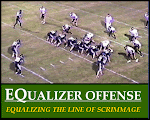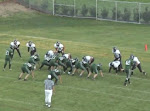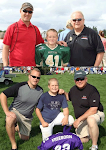
Sunday, March 29, 2009
Sunday, March 22, 2009
What Plays?
Got the follwoing email from a coach:
Coach Freeb,
What plays would you run from the EQ with 10-12 year olds?
John
Here's my answer:
What would we run at that age would be........Dive - Base Play; Dive Option when the DE is stepping down to tackle the FB.
First, we would narrow down the splits of the line to not allow any insider penetrators; we would be at 1 foot or even 6 inches. Then we would have the FB state at a depth of 4 yards and time things up from there. Then we would have the TB be at 6 yards to start.
Dive Option is really a play off of the most successful play at the 10 year old level, i.e, the QB sweep. Only difference? We put a fake to the FB in on the way around the end to freeze the defense; that way the QB can gain more yardage out there.
BTW - at the end of the run, if the QB is threatened by a tackler, just pitch the ball back to a trailing TB for more yardage.
Blast 34 to pick up short yardage; counter 49; and 89 reverse with the Split End coming around if you have a SE that has some speed. It is as effective as a QB sweep.
Final running play: TB Sweep from the offset I.
For pass plays I would run the Dive Option 48 pass, Quick pass one, two and three, looking to get the ball to the inside receivers in the seam at a depth of 8-9 yards and let them run with it after that.
Coach Freeb,
What plays would you run from the EQ with 10-12 year olds?
John
Here's my answer:
What would we run at that age would be........Dive - Base Play; Dive Option when the DE is stepping down to tackle the FB.
First, we would narrow down the splits of the line to not allow any insider penetrators; we would be at 1 foot or even 6 inches. Then we would have the FB state at a depth of 4 yards and time things up from there. Then we would have the TB be at 6 yards to start.
Dive Option is really a play off of the most successful play at the 10 year old level, i.e, the QB sweep. Only difference? We put a fake to the FB in on the way around the end to freeze the defense; that way the QB can gain more yardage out there.
BTW - at the end of the run, if the QB is threatened by a tackler, just pitch the ball back to a trailing TB for more yardage.
Blast 34 to pick up short yardage; counter 49; and 89 reverse with the Split End coming around if you have a SE that has some speed. It is as effective as a QB sweep.
Final running play: TB Sweep from the offset I.
For pass plays I would run the Dive Option 48 pass, Quick pass one, two and three, looking to get the ball to the inside receivers in the seam at a depth of 8-9 yards and let them run with it after that.
Thursday, March 12, 2009
Urban's Way
I picked up the book, Urban's Way, to read on the plane. It is about Urban Meyer and his coaching journey. Very Good. I would recommend that all you involved in coaching go out and get a personal copy.
He makes repeated references to weight training and conditioning. As a 115 pound Frosh, he said he used the weights as his 'secret weapon' to transform him to a 175 pound starter that put him on the path to signing a pro baseball contract and a free safety in college.
After reading the book, or even before, call BFS and schedule up a clinic to transform your skinny freshmen in to varsity athletes. It will change their lives and transform your program.
Be11!
RF
He makes repeated references to weight training and conditioning. As a 115 pound Frosh, he said he used the weights as his 'secret weapon' to transform him to a 175 pound starter that put him on the path to signing a pro baseball contract and a free safety in college.
After reading the book, or even before, call BFS and schedule up a clinic to transform your skinny freshmen in to varsity athletes. It will change their lives and transform your program.
Be11!
RF
Wednesday, March 11, 2009
Sunday, March 8, 2009
EQuote of the Week:
03.08.2009
03.08.2009
When people achieve something
That they've really work hard for
It makes them feel, great superb, wonderful.
Coach K
It makes them feel, great superb, wonderful.
Coach K
 After finishing runner-up twice in the last three seasons, the Pioneers climbed back on top Saturday night with a 46-37 win over previously unbeaten South Eugene in the OSAA Class6A final. In winning their first title since a four-year run ended in 2004 -- and their 11th championship overall -- the Pioneers lived up to their slogan:
After finishing runner-up twice in the last three seasons, the Pioneers climbed back on top Saturday night with a 46-37 win over previously unbeaten South Eugene in the OSAA Class6A final. In winning their first title since a four-year run ended in 2004 -- and their 11th championship overall -- the Pioneers lived up to their slogan:"Taking Back What's Ours."
Question of the Week?
What are you "working hard" to achieve?
Thursday, March 5, 2009
Tuesday, March 3, 2009
Defending the Sweep
The next play in the Wing T progression is the HB sweep. A fake is made to the FB up the middle and the ball is given to the TB on a sweep. The play, however, is really not a sweep but a long trap. The guards pull and the lead guard kicks out the force man, the trail guard turns up field behind this lead block and leads the ball carrier who cuts up into the created running lane. Lombardi made this his signature play (only not from the Wing T). If you have seen his videos, you will remember him describing how the "object is to create a running alley (lane) for the ball carrier.
Running a good sweep involves discipline, timing, and execution. Stopping the sweep involves discipline, timing and execution. Execution for us is like character: "You can either have character or be a character;" "You can either execute or be executed." We prefer a defensive team of executioners.
Our online playbook at www.addy.com/coachfree spells out detailed instructions for Secondary play - reading keys in particular. Briefly stated: When the receivers block, the secondary supports for run; when the receivers head out for pass, the secondary covers those receivers and intercept the pass; when the receivers release for cross field blocks, the secondary rotates to prevent cutbacks and long gains. I am reminded of what Coach Lou Holtz said about coaching the secondary under Coach Hayes at Ohio State in the 60s:
“We were undefeated and the No. 1 team in the U.P.I. poll. Southern California was likewise undefeated and had a great back by the name of O.J. Simpson and was No. 1 in the A. P. Poll. It was obvious to everyone that the winner of the Rose Bowl which matched Ohio State and Southern California would win the National Championship. I coached the secondary which was comprised of Jack Tatum, Mike Sensibaugh, Ted Provost, Tim Anderson and Mike Poloski. I explained that playing in the secondary was really quite simple. When O.J. ran the ball to come up and tackle him. When Sogge threw the ball to Dickerson or Chandler to drop back and cover the receiver they threw to. They would send out four men and three of them would be decoys and only on would be the intended receiver. The secret would be not to cover the decoys but only cover the receiver. If four of them couldn't cover one receiver, they were unworthy to play for Ohio State.”
Stopping the sweep begins on the inside and works its way out. Once again our defensive rules are:
1. Proper Stance and Alignment;
2. Make your move/Strike the opponent
3. Read your Keys;
4. Locate the Football/Pursue
5. Gang tackle the ball carrier.
The DT's align on the inside eye of the OG's. They are responsible for striking the opponent. On sweep left, the LT may not get a great strike on the G because he is pulling away from him. Since this G is pulling, the job of the DT is to get on the hip of the G and move down the LOS with him. The RDT should get a great strike on the OG since he is aligned on an inside shade. The DT should disrupt the pull of the G, move around the seal block of the C and join his counterpart executing an inside out force on the play. The MLB'er still reads the head of the C. When the C's head moves right to seal for the pulling G, M fills left into the vacated area. He should "read the G's on the run," see them pulling, and move to the left with an inside out force on his "run through." His best possible fill would be to cross the LOS, adjust his angle of pursuit, and tackle the ball carrier as he cuts to the LOS. The least M can do is to further disrupt the pulling G and prevent him from getting in front of the ball carrier thus destroying the timing and execution of the play.
At the edges of the defense destroying the sweep hinges on good secondary key recognition. When playing a Wing T team, we get into cover 2 a lot. Cover 2 for us puts us into what essentially becomes a 4-5-2 defense. The secondary keys are the E and WB and near back; When they block down, the secondary supports immediately. We play the DE on the inside eye of the TE and the DE is responsible for striking the TE and controlling the C gap keeping his shoulders square to the LOS. Playing like this forces the TE to block the DE giving the secondary a quick and true read. We believe that the sooner the secondary can read their key, the sooner the play can be stopped. The SLB'er keys through the G to the back. In a Wing T scheme it is the far back/TB that poses the main threat to S. Depending on the scouting report or the defensive call, we will either have S fill and execute a "run through" the B gap, or more likely have him shuffle outside, defeat the block of the WB and be standing in the lane/D gap and meet the ball carrier on or near the LOS.
It is the responsibility of the SS or the CB to contain the play. They are to support from the outside in. Good key recognition will put the SS/CB on or beyond the LOS, squeezing the play from the outside in, thereby reducing the size of the "alley" or running lance that the ball carrier has to cut to. The SS/CB's responsibility is to "turn the play in" into the pursuit coming from the inside.
The HB reads key (end blocks) and supports straight ahead into the proposed running lane. The Wing T scheme is to have a pulling G move to block the HB. The play of our DT's, M, S and DE should prevent the G from being near the running lane before the ball carrier gets there.
At times you can have S and W play like M, only S/W read the OT's head. If the OT blocks down, have S/W fill through the area vacated by the OT. This will lead to an immediate tackle for loss opportunity - there is absolutely no one who can block S/W, neither are they expecting him to be there. When everyone executes their responsibilities according to design, any danger of the sweep is nullified.
We believe that you cannot stay in the same alignment the whole evening (unless you have them outmatched, in that case it just doesn't matter). Keeping in line with our philosophy of committing 3 defenders to the 2 A gaps, we will run what we call "3 Down." In 3 down we put M down over the C and the 2 DT's align inside shade as normal. M's responsibility is to hit and drive C straight back into the lap of the QB which happens quite often because:
1. If you are like us, the people who play LB'er, especially M, are your better athletes.
2. Often other teams make the mistake of playing a lesser athlete at C.
These two factors create a mismatch. Many times the timing of the play is destroyed because M drives C back into the path of the pulling guard who is driven back further disrupting the play's timing and routes of the ball carrier.
A variation of 3 down is "3 down gap" where the 3 down interior men align in the gaps to the TE side of the ball. When aligned in the gaps, we want the 3 guys to penetrate as soon and as deep as possible tackling the near back in route. We have had unexpected success with 3 down. In fact, over the years we have had M on more than one occasion intercept a hand off-even score which, of course, is most demoralizing. With these 3 basic calls (base 4-3, 3 down, and 3 down gap) along with goal Line, we have been able to keep the Wing T teams under control when we are somewhat evenly matched. If you are way overmatched, then it just doesn't matter. You must commit yourself and your team to the weight room to narrow the gap for next year.
To Summarize: Sweep Defense involves
1. Disrupting the blockers
2. Proper pursuit
3. Forceing the play on or beyond the LOS from the outside in, keeping your outside arm and leg free.
4. Gang Tackle.
Running a good sweep involves discipline, timing, and execution. Stopping the sweep involves discipline, timing and execution. Execution for us is like character: "You can either have character or be a character;" "You can either execute or be executed." We prefer a defensive team of executioners.
Our online playbook at www.addy.com/coachfree spells out detailed instructions for Secondary play - reading keys in particular. Briefly stated: When the receivers block, the secondary supports for run; when the receivers head out for pass, the secondary covers those receivers and intercept the pass; when the receivers release for cross field blocks, the secondary rotates to prevent cutbacks and long gains. I am reminded of what Coach Lou Holtz said about coaching the secondary under Coach Hayes at Ohio State in the 60s:
“We were undefeated and the No. 1 team in the U.P.I. poll. Southern California was likewise undefeated and had a great back by the name of O.J. Simpson and was No. 1 in the A. P. Poll. It was obvious to everyone that the winner of the Rose Bowl which matched Ohio State and Southern California would win the National Championship. I coached the secondary which was comprised of Jack Tatum, Mike Sensibaugh, Ted Provost, Tim Anderson and Mike Poloski. I explained that playing in the secondary was really quite simple. When O.J. ran the ball to come up and tackle him. When Sogge threw the ball to Dickerson or Chandler to drop back and cover the receiver they threw to. They would send out four men and three of them would be decoys and only on would be the intended receiver. The secret would be not to cover the decoys but only cover the receiver. If four of them couldn't cover one receiver, they were unworthy to play for Ohio State.”
Stopping the sweep begins on the inside and works its way out. Once again our defensive rules are:
1. Proper Stance and Alignment;
2. Make your move/Strike the opponent
3. Read your Keys;
4. Locate the Football/Pursue
5. Gang tackle the ball carrier.
The DT's align on the inside eye of the OG's. They are responsible for striking the opponent. On sweep left, the LT may not get a great strike on the G because he is pulling away from him. Since this G is pulling, the job of the DT is to get on the hip of the G and move down the LOS with him. The RDT should get a great strike on the OG since he is aligned on an inside shade. The DT should disrupt the pull of the G, move around the seal block of the C and join his counterpart executing an inside out force on the play. The MLB'er still reads the head of the C. When the C's head moves right to seal for the pulling G, M fills left into the vacated area. He should "read the G's on the run," see them pulling, and move to the left with an inside out force on his "run through." His best possible fill would be to cross the LOS, adjust his angle of pursuit, and tackle the ball carrier as he cuts to the LOS. The least M can do is to further disrupt the pulling G and prevent him from getting in front of the ball carrier thus destroying the timing and execution of the play.
At the edges of the defense destroying the sweep hinges on good secondary key recognition. When playing a Wing T team, we get into cover 2 a lot. Cover 2 for us puts us into what essentially becomes a 4-5-2 defense. The secondary keys are the E and WB and near back; When they block down, the secondary supports immediately. We play the DE on the inside eye of the TE and the DE is responsible for striking the TE and controlling the C gap keeping his shoulders square to the LOS. Playing like this forces the TE to block the DE giving the secondary a quick and true read. We believe that the sooner the secondary can read their key, the sooner the play can be stopped. The SLB'er keys through the G to the back. In a Wing T scheme it is the far back/TB that poses the main threat to S. Depending on the scouting report or the defensive call, we will either have S fill and execute a "run through" the B gap, or more likely have him shuffle outside, defeat the block of the WB and be standing in the lane/D gap and meet the ball carrier on or near the LOS.
It is the responsibility of the SS or the CB to contain the play. They are to support from the outside in. Good key recognition will put the SS/CB on or beyond the LOS, squeezing the play from the outside in, thereby reducing the size of the "alley" or running lance that the ball carrier has to cut to. The SS/CB's responsibility is to "turn the play in" into the pursuit coming from the inside.
The HB reads key (end blocks) and supports straight ahead into the proposed running lane. The Wing T scheme is to have a pulling G move to block the HB. The play of our DT's, M, S and DE should prevent the G from being near the running lane before the ball carrier gets there.
At times you can have S and W play like M, only S/W read the OT's head. If the OT blocks down, have S/W fill through the area vacated by the OT. This will lead to an immediate tackle for loss opportunity - there is absolutely no one who can block S/W, neither are they expecting him to be there. When everyone executes their responsibilities according to design, any danger of the sweep is nullified.
We believe that you cannot stay in the same alignment the whole evening (unless you have them outmatched, in that case it just doesn't matter). Keeping in line with our philosophy of committing 3 defenders to the 2 A gaps, we will run what we call "3 Down." In 3 down we put M down over the C and the 2 DT's align inside shade as normal. M's responsibility is to hit and drive C straight back into the lap of the QB which happens quite often because:
1. If you are like us, the people who play LB'er, especially M, are your better athletes.
2. Often other teams make the mistake of playing a lesser athlete at C.
These two factors create a mismatch. Many times the timing of the play is destroyed because M drives C back into the path of the pulling guard who is driven back further disrupting the play's timing and routes of the ball carrier.
A variation of 3 down is "3 down gap" where the 3 down interior men align in the gaps to the TE side of the ball. When aligned in the gaps, we want the 3 guys to penetrate as soon and as deep as possible tackling the near back in route. We have had unexpected success with 3 down. In fact, over the years we have had M on more than one occasion intercept a hand off-even score which, of course, is most demoralizing. With these 3 basic calls (base 4-3, 3 down, and 3 down gap) along with goal Line, we have been able to keep the Wing T teams under control when we are somewhat evenly matched. If you are way overmatched, then it just doesn't matter. You must commit yourself and your team to the weight room to narrow the gap for next year.
To Summarize: Sweep Defense involves
1. Disrupting the blockers
2. Proper pursuit
3. Forceing the play on or beyond the LOS from the outside in, keeping your outside arm and leg free.
4. Gang Tackle.
Subscribe to:
Posts (Atom)











